Vintage Spirits and Forgotten Cocktails
Drinks From the Past for the Future

Hotel Nacional Special
Another one from Cuba: the Hotel Nacional Special:
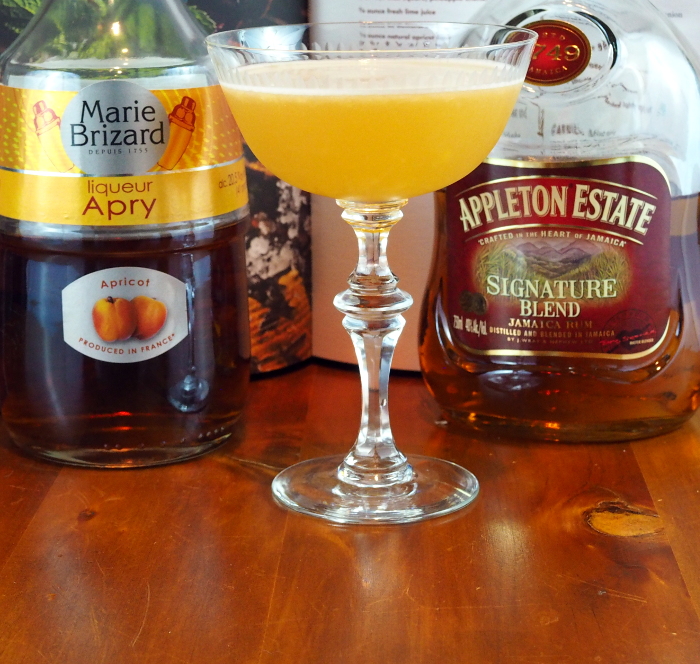
- 3 or 4 (1-inch square) pineapple chunks
- 0.75 ounce lime juice
- 0.50 ounce SC Demerara Syrup
- 0.50 natural apricot liqueur (such as Rothman & Winter Apricot Liqueur or Gifford Abricot du Roussillon)
- 1.5 ounces blended lightly aged rum
In a cocktail shaker, muddle the pineapple chunks with the lime juice and syrup. Add the apricot liqueur and the rum, then fill with cracked or cubed ice. Shake and double strain into a chilled coupe.
This may be my new favorite cocktail. Previously, it was the Golden Dawn, which is also the order I place to test the knowledge of bartenders new to me (just for the record, with that drink the correct method is to use equal proportions, sorry Justin).
This recipe is from the Smuggler’s Cove book. Like the Daisy de Santiago it is adapted from The Gentleman’s Companion. I recently got a copy but haven’t had time to read much of it, but I do like Baker’s style.
His recipe was somewhat different:

One of the things I like about this hobby is that I learn a lot. In his recipe he called for Gold (de Oro) Bacardi. Bacardi white rum was one of the first spirits I ever drank, yet I didn’t know that the company originated in Cuba. Bacardi is one of the largest suppliers of spirits in the world, and a good number of the ingredients I use in these cocktails are actually from Bacardi brands (such as Bénédictine liqueur).
I also learned about the interesting history of the Hotel Nacional. Baker planned to visit in 1933, but the Hotel was the site of a military battle between enlisted men loyal to Batista and Army officers loyal to the previous government. It was also the location of the infamous Havana Conference meeting of all of the influential mob bosses from the United States. This was memorialized in the movie The Godfather, Part II
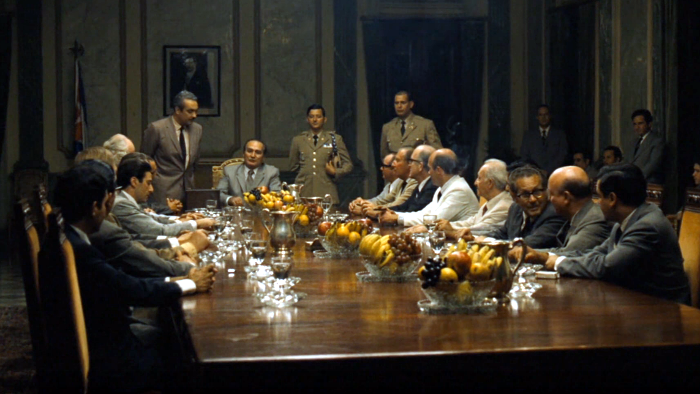
Who says cocktails and education can’t go hand in hand?
I love this drink. It is perfectly balanced and I could drink a pitcher of them. One thing I’ve struggled with in making cocktails that include pineapple is finding a way to get fresh juice. It is easy to juice citrus but I don’t have a machine to easily extract the juice from things like pineapples. I never thought about muddling the pineapple and that works really well. As with most drinks containing pineapple juice, shaking them will create a kind of thickness (and a foam) and you do need to double strain as it can be hard to get all of the drink out of the shaker.
I also got to use my new, pretty coupe that I bought at a thrift shop for $1.
Rating: 5/5 – I would give it a 6 if my system went that high.
Notes: I used Appleton Estate’s Signature Blend rum, which is a wonderful lightly aged rum that is also affordable. I also used Marie Brizard Apry apricot liqueur because that’s what Dr. Cocktail told me to use and I quite like it. I’ve had the Rothman & Winter as well and it is great, I just don’t have a source for it in North Carolina.
Daisy de Santiago
From Cuba comes the Daisy de Santiago:
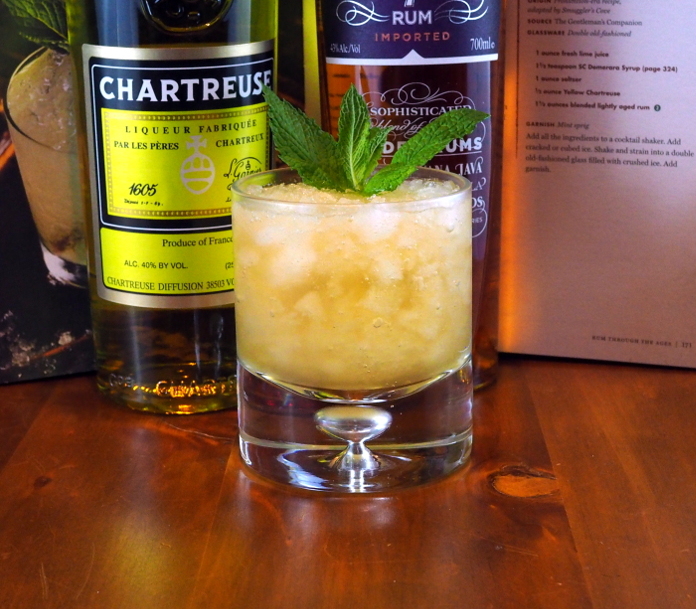
- 1.0 ounce lime juice
- 1.5 teaspoons SC Demerara Syrup
- 1.0 ounce seltzer
- 0.5 ounce Yellow Chartreuse
- 1.5 ounces blended lightly aged rum
Add all the ingredients to a cocktail shaker. Add cracked or cubed ice. Shake and strain into a double old-fashioned glass filled with crushed ice. Garnish with a mint sprig.
This recipe is from the Smuggler’s Cove book but it is adapted from The Gentleman’s Companion: Around the World with Jigger, Beaker and Flask by Charles H. Baker, Jr. Baker was a food and drink writer who traveled the world and told stories. It sounds like my dream job. The Daisy de Santiago he discovered in Cuba, and referred to it as a “lovely thing, indeed”.
I am hoping to be able to visit Cuba toward the end of the year, so I am studying up on both my Spanish and the amazing world of Cuban cocktails. Of course, the most famous is probably the Daiquiri, but being in the Caribbean there are a number of wonderful drinks, mainly based on rum, to come out of that country. I am eager to drink where Hemingway once did.
This cocktail basically uses a Daiquiri as its base, but adds in the unusual ingredient of Yellow Chartreuse (as well as seltzer). Chartreuse is an herbal liqueur made for hundreds of years by monks in France. It comes in two varieties, Green and Yellow. My first exposure to Chartreuse of any sort came in December of 1984. I was living in Los Angeles dating a young woman from Palos Verdes. She invited me, along with a few other friends, over to her parents’ house for a meal. I don’t remember much about the meal, but I do remember her father offering us an after dinner drink. Since we were all under the age of 21 at the time we jumped at the chance, but our attitudes quickly changed when we drank the Chartreuse. To say that it is an acquired taste is a vast understatement. I can’t remember if I had the Green or the Yellow, but I remembered not liking it at all.
Which is funny, now, since I go through a lot of Green Chartreuse in the Last Word cocktail, which is a favorite. This was the first time I used Yellow Chartreuse. It is milder than the Green and adds an interesting herbal note to this cocktail without overpowering it.
Which I believe would be easy to do, since this whole drink is mild and refreshing. Everything is well balanced, and while it didn’t “grab” me it was welcome on a hot day.
I do want to emphasize the garnish, here. Due to it being summer, mint is now more plentiful and the smell of the fresh mint as you drink the Daisy de Santiago adds a lot to the experience. It is required – like the Cuba Libré without the lime becomes just Rum and Coke.
Notes: I used some of my Banks 7 rum in this drink, and I think it worked out well.
Hermosa Beach
From Connor at the Oakleaf, it’s the Hermosa Beach:
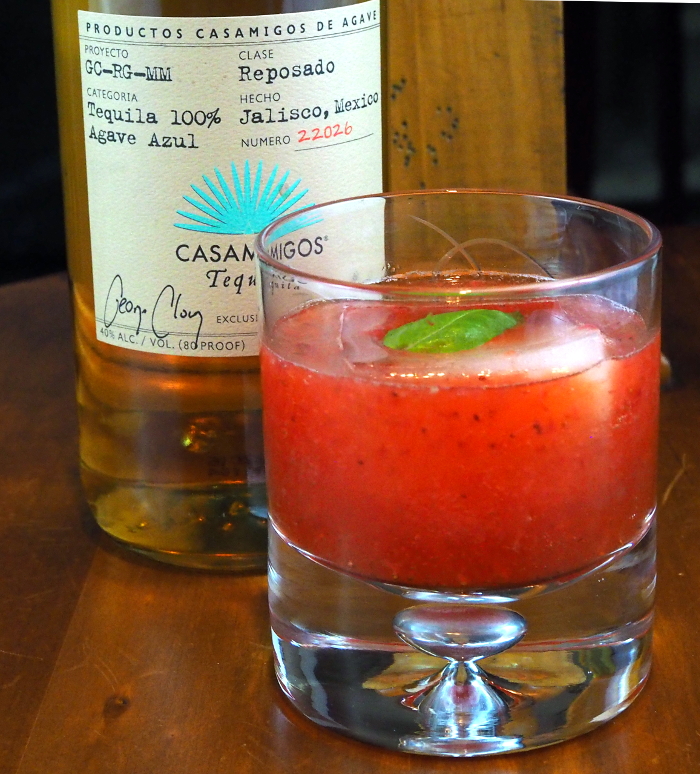
- 0.50 ounce lime juice
- 0.50 ounce Demerara Syrup
- 2.00 ounces reposado tequila
- 4-6 chunks of strawberry
- 1 large bruised basil leaf
Muddle strawberry and basil in a shaker glass. Add other ingredients and strain over a large cube of ice. Garnish with a small basil leaf.
This is a fine drink that lends itself to a lot of off-topic comments.
First, this demonstrates what I love about true craft cocktails. I often refer to people who make them as “cocktail chefs” instead of bartenders, although there is absolutely nothing wrong with the term “bartender”, it’s just that I want to illustrate what goes in to a great cocktail recipe. In this case it is seasonal ingredients like the strawberries and fresh basil. Just as chefs will use nature as a template for meals, a good bartender will look toward the same sources for inspiration.
Second, this drink’s focus is on tequila. My first exposure to tequila, and pretty much all non-clear spirits, was in the form of a “shot”. You would quickly down the liquor and follow it up with some sort of chaser to kill the taste. Now that I’ve become familiar with spirits I have a visceral negative reaction whenever I see people downing shots of anything. Seriously, if it isn’t worth sipping and savoring don’t drink it. Similar to spicy food, it takes a bit of exposure to start to taste the nuances, but it is worth it. Much like a single malt scotch or a good sweet bourbon, tequila has become a spirit to be appreciated on its own.
Finally, it is nice to have Connor back at the Oakleaf. He worked there as a waiter several years ago, but left to move to New York City (yes, there was a woman involved). Now, he has moved back (and yes, there was a woman involved) and I’m very happy he did. While, before, he didn’t work the bar except at lunch, he has returned with a wealth of cocktail knowledge and experience, and it has made me miss Justin, the previous cocktail chef, a little less.
Well, back to the drink. A good friend and neighbor of mine moved to Texas several years ago. He doesn’t fly so I had to wait for him and his wife to take a road trip that brought them back through North Carolina. They wanted to go to the Oakleaf, and when I learned he had developed a taste for tequila while in Texas I insisted he try this drink. His reply was “Mmmm, that’s dangerous” and I could see his point. One could drink a pitcher of these, easily.
Notes: Espolon tequila was called for, but I don’t have any so I used something I did have, Casamigos. This is a highly rated tequila created, in part, by George Clooney. Note that you’ll want to use a reposado in this drink as a blanco wouldn’t lend enough character.
Three Dots and A Dash
Morse code for Victory, it’s Three Dots and a Dash:
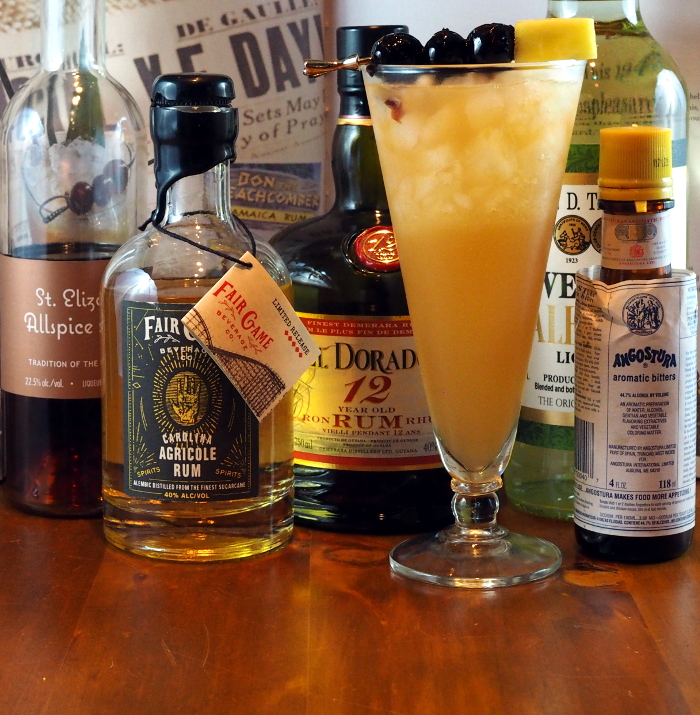
- 0.50 ounce lime juice
- 0.50 ounce orange juice
- 0.50 ounce SC Honey Syrup
- 0.25 ounce John D. Taylor’s Velvet Falernum
- 0.25 ounce St. Elizabeth Allspice Dram
- 1.50 ounces cane AOC Martinique rhum agricole vieux
- 0.50 ounce blended aged rum
- 1 dash Angostura bitters
Add all ingredients to a drink mix tin. Fill with 12 ounces of crushed ice and 4 to 6 small agitator cubes. Flash blend and open pour with gated finish into a footed pilsner glass. Garnish with three cherries and a pineapple chunk on a cocktail pick.
This is another recipe from the wonderful Smuggler’s Cove book, but it caught my eye for a totally different reason.
Some time ago I was in Chicago and I got to visit with my friend Demetri. We hadn’t seen each other in awhile and there was a lot to catch up on, so we started off at the the Florentine restaurant bar, home of Life is Beautiful, their take on the Brooklyn and one of my favorite cocktails. They have happy hour pizzas, but after a few drinks we adjourned to find some healthier food. After we ate we ran into a friend of his named Marne, and the three of us ended up at this basement tiki bar called Three Dots and a Dash.
There is nothing better than hanging out with interesting people over amazing drinks. Now, the drinks at Three Dots can be the size of your head, so they are best shared. While I’ve known Demetri for over a decade it was also nice to chat with Marne. One of the amazing things she does is put together “goodie bags” for homeless people. This is a gallon ziplock bag which includes water, snacks (like crackers), band-aids, disinfectant, and other useful things a person living on the street might need. Being gentlemen, at the end of the night we walked her back to her car (a yellow Pontiac Aztec with a bumper sticker that read “If mountain biking were easy, it would be called your Mom”) and a homeless lady approached us for a donation. Marne, with obvious practice, said that she wouldn’t give any money but to come to her car and she’d did have something for her. It was kind of cool to watch the lady’s expression go from confusion to surprise to satisfaction in just a few seconds as she looked in the bag.
Anyway, back to this drink.
The cocktail calls for a specific version of rhum agricole that I didn’t have, but I did have a bottle of the Fair Game rhum agricole that I was eager to try in this cocktail. Rhum agricole is distilled directly from sugar cane juice, whereas traditional rum is distilled from molasses, a by-product of the distillation process. Rhum agricole became popular once sugar production in the Caribbean grew to the point that it could be used for something like rum versus being refined for regular sugar. The Fair Game version is made from local sugar, and I like it so much I gifted a bottle to my friend Lorenzo at the wonderful Dry Martini bar in Barcelona. It has some nice grassy overtones missing in regular rum.
This drink also calls for honey syrup. The Smuggler’s Cove recipe is a 1:1 ratio of honey to water, where you heat the honey first to make it easier to incorporate with the water. I love honey in drinks but it can be tricky to use.
It was a very nice drink, but I’m going to ding it a star because it tasted a lot like other tiki drinks and didn’t really have a distinctive flavor of its own. Part of that could be that the Fair Game rhum is not aged, so if I can get my hands on some aged rhum agricole I will revisit it.
Notes: As per my usual complaint, I can’t get the more unusual spirits used in craft cocktails in North Carolina. The John D. Taylor’s Velvet Falernum was “muled” up from Florida by friends of mine. For the blended aged rum I used El Dorado 12-year.
Another classic from Death & Co., the Flamenco:
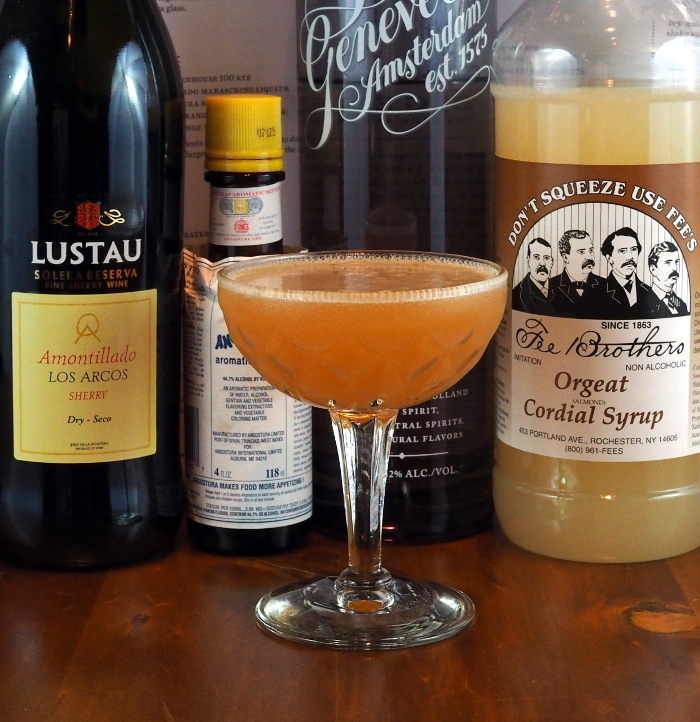
- 1.50 ounces Lustau Amontillado Sherry
- 1.00 ounce Bols Genever gin
- 0.50 ounce orange juice
- 0.50 ounce lemon juice
- 0.75 ounce orgeat
- 2 dashes Angostura bitters
Shake all the ingredients with ice, then strain into a coupe. No garnish.
My biggest challenge in making drinks from the Death & Co. book is finding the ingredients. I was looking for a cocktail to make and was happy to see that I had everything to make this one.
However, even though it is in the “classics” section, I couldn’t find any outside reference to the Flamenco. Many recipes in the search results cited the book as a reference, and there were a number of completely different recipes so I’m not sure of the history on it.
The drink is dominated by the taste of sherry, and I’m not a huge sherry fan. I did like it, but it wasn’t something I’d seek out – the sweetness of the sherry is a little cloying to me.
Notes: I know I need to make my own orgeat, but I’ve been perfectly happy using Fee Brothers so I did so here. Otherwise I used the ingredients as specified.
Brown Derby
From the Golden Age of Hollywood comes the Brown Derby:
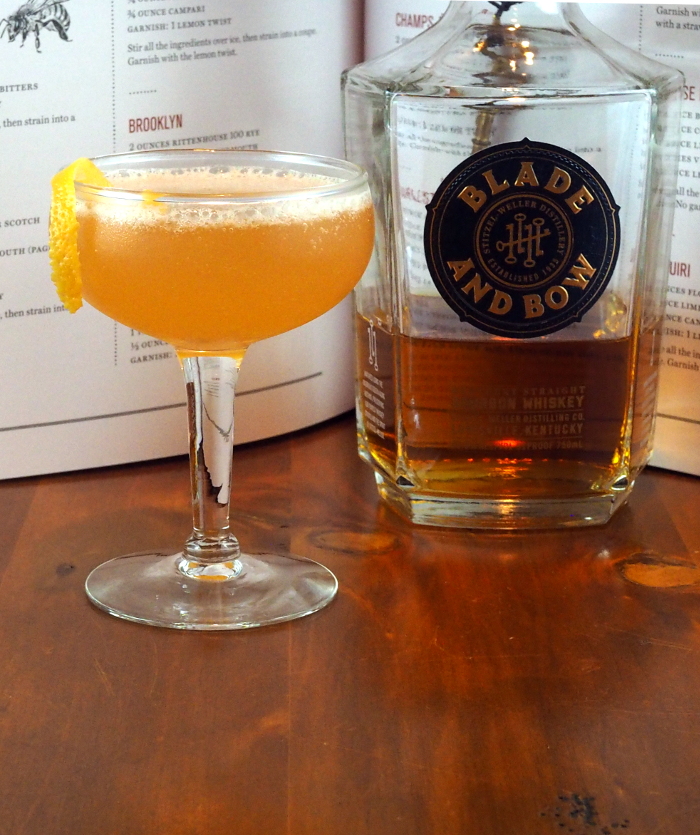
- 2.0 ounces Elijah Craig 12-year Bourbon
- 1.0 ounce grapefruit juice
- 1.0 teaspoon lemon juice
- 0.50 ounce Acacia Honey Syrup
Shake all the ingredients with ice, then strain into a coupe. Garnish with a grapefruit twist.
The Brown Derby restaurant chain in Los Angeles consisted of a number of restaurants, with the first and most iconic being in the shape of a hat. In researching this cocktail I’ve uncovered a rather interesting story. In the 1930s, the drink was the signature drink at a competing restaurant called the Vendome Club. Originally called the “De Rigueur” in cocktail books, it somehow morphed into the Brown Derby over time.
I dug this recipe out of the Death & Co. book, as I saw on Twitter they were excited to now have 100K followers. It took me a second to realize that the post was from the Instasnap and I guess automatically posted to Twitter (they only have a little over 2K followers there). Since I don’t use that social network I doubt I can participate in the #100KDEATHANDCO promotion, but since their cocktails are always interesting I wanted to revisit the book and make a couple in any case.
I started browsing through the “Classics” section, and the first recipe that caught my eye was the Brown Derby because of the grapefruit. I had just made the Whoa Nellie! which also included grapefruit, and since I like bourbon I figured I’d give this one a shot. Most Brown Derby recipes omit the lemon juice, and to make the honey syrup take Acacia Honey and mix it in a sealable container with warm water 2:1, and then shake the heck out of it.
Rating: 4/5, I did like the Whoa Nellie! more, but this is a solid drink.
Notes: My biggest complaint with the Death & Co. book is that often the spirits they use are very hard to find, especially in North Carolina. I don’t have the Elijah Craig they call for but I do have some Blade & Bow. I was recently in Pikeville, Kentucky (home of the Hatfields and McCoys) and when I asked the locals for their sage advice concerning bourbon, everyone I talked to suggested Blade & Bow. They did not steer me wrong, it is amazing. As you can see I’m going to need another bottle soon.
Whoa Nellie!
A new classic, it’s the Whoa Nellie!:
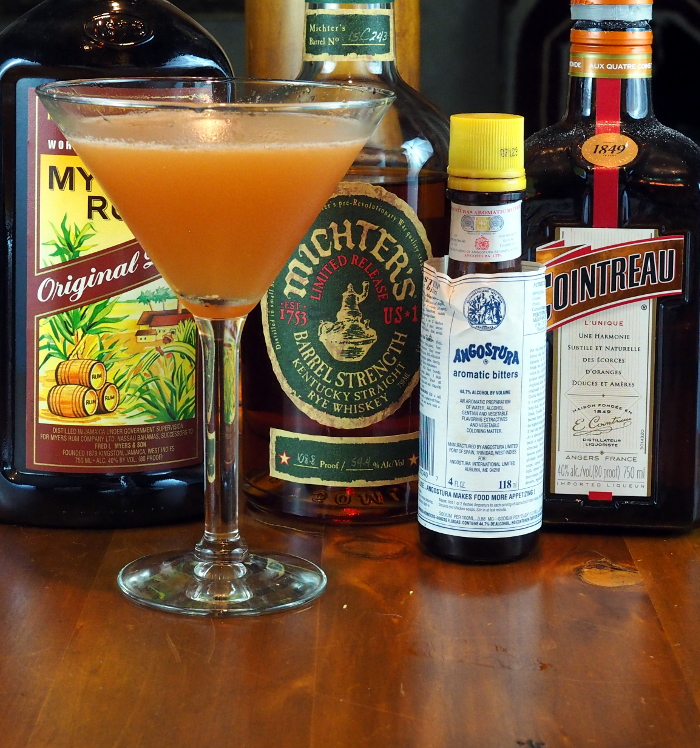
- 1.25 ounces rye
- 0.75 ounce dark rum
- 0.75 ounce Cointreau
- 4 dashes Angostura bitters
- 0.50 ounce lemon juice
- 0.50 ounce grapefruit juice
- 0.50 ounce simple syrup
Combine all of the ingredients into a shaker and shake vigorously. Strain into a chilled martini glass.
My friend Ben and I share a fondness for whiskey, and together we have a decent collection. Unfortunately, we live more than an hour apart, so it made sharing them difficult until we decided we could just bring them to work. Thus “Whiskey Monday” (#whiskeymonday) was born.
Now, before you think all we do at work is sit around and drink, this is just a “wee dram” to start off the week and to explore the flavors of different spirits. When it was last my turn to bring something in, I grabbed a bottle of Michter’s Barrel Strength Rye that Ben had given to me as a gift on my fiftieth birthday. It was very tasty, and I wanted to use it in a cocktail.
I have used rye in a number of recipes on this blog. Rye features prominently in classics like the “Sazerac” and the “Vieux Carré”, and there are some wonderful modern rye cocktails such as my namesake “Tarus the Bull” and the excellent “Drove My Chevy to the Levy”, but I wanted to make something new.
I went to the bookshelf, but it seems like rye drinks get the short shift. Since I came up empty, I went searching on the Intertoobz when I came across the mention of a drink called the “Whoa Nellie!”
This drink originates from the 2006 Mardi Gras celebration in New Orleans. Not only is it fitting that a rye cocktail should come from that town, the fact that it rose out of the first Mardi Gras after the devastation of Katrina seems appropriate as well. Of course, I don’t get invited to parties like this, but at a party hosted by Lally Brennan along the parade route, there were a number of cocktail aficionados including Doctor Cocktail. The story goes:
Late at night, Doc was charged with the responsibility of creating a new drink. The Doc started rummaging through Lally’s liquor cabinet. After some Morgus-like failures, “divine inspiration then intervened,” and when he took a sip, he knew he had hit a home run and said, “Whoa, Nellie!”
It seemed to be just what I was looking to make, and with the citrus and rum components it fit in with the drinks I have been making from the Smuggler’s Cove tiki book.
The rye and grapefruit hark back to the “Blinker” but the rum adds even more complexity. I usually sip my cocktails, so I was surprised to find it almost gone after a few minutes.
It really did help showcase the Michter’s Rye as well. Rye is often associated with blends, especially Canadian whiskey, but one of the go-to rye’s for classic cocktails is Rittenhouse 100, a 100 proof spirit. This rye clocks in at nearly 109 proof, so it isn’t shy but still manages to be smooth and flavorful.
Notes: Outside of the Michter’s, I used Myer’s Dark Rum (as instructed) but I believe a number of other dark rums would work as well.
In honor of Mardi Gras, I made a Hurricane:

Combine all of the ingredients in a drink mixer tin. Fill with 12 ounces of crushed ice and 4 to 6 small “agitator” cubes. Flash blend and open pour with a gated finish into a 15 oz. hurricane glass. Garnish with a wind-ravaged cocktail umbrella speared into a lemon wedge.
And by “Mardi Gras” I mean New Orleans’ Mardi Gras, which I attended for the first and only time in 1990. It was there I was introduced to the ubiquitous “Hurricane” – a large, bright red, super-sweet strong rum drink. These days you can buy them in fish bowls and walk around with one around your neck.
While I don’t have much sequential memory of that first trip, I do remember my next visit which was in the Spring of 1991. It was the perfect time to visit New Orleans, between the madness that is Mardi Gras and the heat of the Jazz Festival. I was there ostensibly as part of a school trip to, I think it was an IEEE conference, but I don’t remember spending much time there.
After an overnight bus ride we ended up in the city mid-morning. Since we couldn’t check into our hotel at that hour, we dropped off our bags and started wandering around the Quarter. We cut down Tchoupitoulas on our way and there we passed a Bookstar book store. A notice in the window caught my eye: Harlan Ellison was in town.
I am a huge Ellison fan, and he used to do this gig where he would come to a book store and sit in the window for a day and write a short story. The “seed” of the story would come from either someone at the store or a local celebrity, and then he would spend the rest of the day writing, pasting the typewritten pages up in the window as he went. If you’ve ever tried your hand at writing you realize how ballsy this was to do.
Anyway, I got real excited but he wasn’t scheduled to be there for a couple of hours, and so to calm down I made my way to the outdoor patio of Pat O’Briens where I had a Hurricane. It wasn’t as sickly-sweet as what you could buy from a street vendor, but they did sell it as a mix where you would just add rum. I still happen to have an unopened bag of it, and as you can see it calls for 4 ounces of rum to 28 ounces of ice and mix, so the version presented here is about twice as strong (and much less sweet).
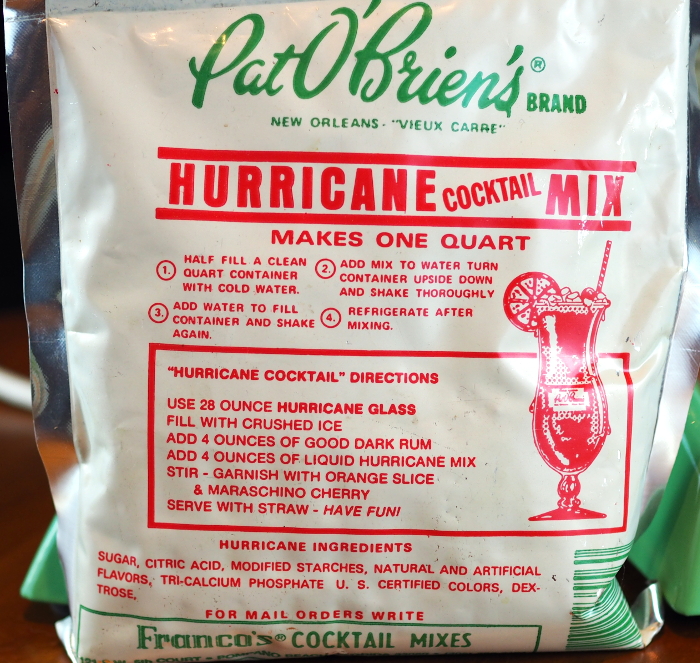
Sufficiently lubricated I made my way to the Bookstar, and there he was, the man himself. While no one who knows me would call me shy, I do tend to be somewhat circumspect when approaching celebrities. As I was standing in the store thinking of a way to approach him, he actually came to me as he needed a pencil and I was standing next to them. He was chatting with a companion who I later learned was George Alec Effinger. They were talking about the route someone would take if they were leaving New Orleans, and Harlan had his character leaving the city in a 1978 Toyota Corolla.
When there was a pause I interrupted the conversation to interject that my father had a blue 1977 Corolla, and the one thing I remember strongly about it was that the air conditioning system was crap, unable to stand up to North Carolina summers much less those of Louisiana. He loved it, and added it to the story. He then asked me for my name, which he also loved, and he asked if he could use it in a story. Of course I said “sure!” although I don’t believe he ever did (and I probably should have added a caveat that the character not be an asshole). He then introduced me to George and the three of us were now conspirators on this new short story.
His character, Ben Laborde, needed a job where he had a travel around the State. I suggested “ATM repairman” and that made the cut as well. Anyway, after lurking for a bit longer I decided to leave on a high note, but I did pick up a copy of Harlan’s latest collection, which was called Angry Candy. He autographed it for me.

The story he wrote that day, “Jane Doe #112”, can be found in his collection Slippage. My tiny contributions can be found on pages 232 and 233 of the hardback first edition.
While I have yet to talk with Ellison again, I did strike up a friendship with Effinger. I still have a number of letters we exchanged over the years and if you haven’t read his Marîd Audran novels you really should. He was taken from us all too soon.
Whew. Anyway, isn’t this a blog about drinks? I strongly tie drinks and memories together, so my apologies.
The recipe for the Hurricane presented here is from the Smuggler’s Cove book and attributed to Beachbum Berry’s take on the Pat O’Brien original. I find I tend to like any drink that has its own glass (although Andrea rolls her eyes whenever I get a new set) and this was no exception. Not nearly as sweet as what you’ll find on the street in the French Quarter, but still very tasty.
Rating: 4/5 (a very strong 4)
Notes: As I’ve mentioned before, I like the fact that Smuggler’s Cove offers a choice of rums for most of their drinks. This one called for “black blended rum” which was category five on their list. The only one that was available to me in North Carolina was Goslings Black Seal. It was affordable and worked well in this cocktail.
SC Passion Fruit Syrup
Another ingredient found in Smuggler’s Cove drinks:
- 1.5 cups Funkin passion fruit puree
- 1.5 cups 2:1 Simple Syrup, cooled
In a bowl, whisk together the fruit puree and the syrup. Pour into a lidded bottle or other sealable container and store in the refrigerator. Will keep for 10 days.
The simple syrup is, well, simple. Mix two parts sugar to one part water, heat and stir until the sugar is dissolved.
I was unable to find Funkin passion fruit puree locally, but Amazon came through. As I was unable to use all of it, I poured the remainder into a ice cube tray and froze it, removing the cubes to a ziplock bag.
Golden Gun
Courtesy of the Cocktail Wonk, it’s the Golden Gun:
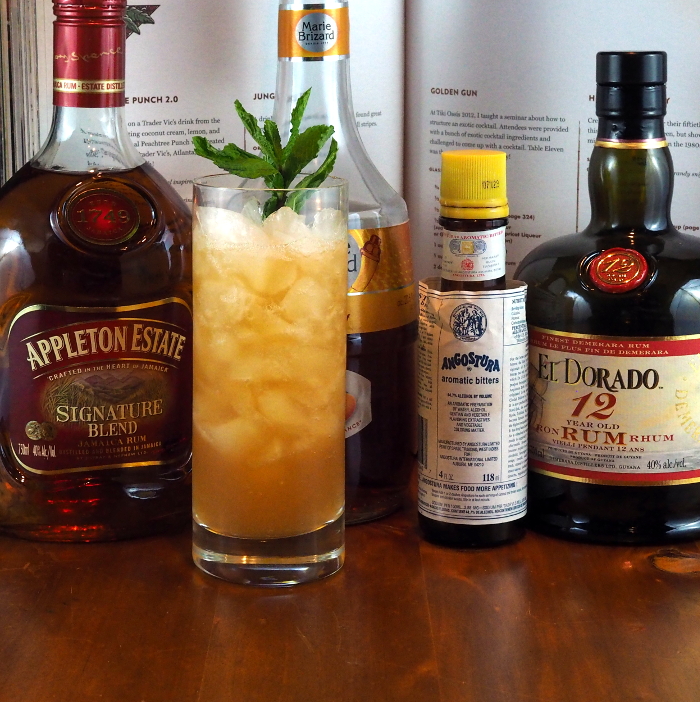
- 0.75 ounce lime juice
- 0.50 ounce grapefruit juice
- 0.50 ounce SC Demerara Syrup
- 0.50 ounce natural apricot liqueur (such as Rothman & Winter Apricot Liqueur or Gifford Abricot du Roussillon)
- 1.00 ounce blended aged rum
- 1.00 ounce blended lightly aged rum
- 2 dashes Angostura bitters
Fill a Collins or highball glass with cracked or cubed ice. Add all the ingredients to a cocktail shaker filled with cracked or cubed ice. Shake and strain into the glass. Your choice of garnish.
The recipe is from the Smuggler’s Cove book, but I came across the book review on Cocktail Wonk while researching rums.
Even before I set out to make all the recipe’s in Ted Haigh’s book, I was a fan of single malt Scotch and was pretty familiar with the culture. Then I moved on to a love affair (still ongoing) with bourbon and rye whiskeys. The rum culture is just as varied and complex but I am a novice. Now in working through Dr. Cocktail’s list of drinks, I did manage to amass a small collection of rum. He would usually give some clue as to what type of rum to use, either by color (white or aged) or region (Jamaica, Guyana, St. Croix), and I would seek out a bottle. Some stymied me: to this day I have not been able to procure a bottle of Coruba, although I did finally see one at a cocktail bar in Reno, and I could never find Lemon Hart 151, but I found a substitute in Hamilton 151 (it does look like Lemon Hart is available at Total Wine now).
In my last post I pointed out how Smuggler’s Cove maps rum into categories, but I have a few bottles that aren’t listed. These include a blend called Zaya that I got as a gift, my bottle of contraband Havana Club 7 a friend brought to me from Canada, and Cruzan Black Strap, which I bought for use in drinks from the Dead Rabbit Drinks Manual. Is “black strap” the same as “black” rum? It says “blended” on the bottle, so can I assume it fits that category?
I was hoping for some answers, specifically I wondered with the success of the book if Martin and Rebbecca Cate had put up some sort of web site with an expanded list. The Smuggler’s Cove is supposed to have over 550 rums at any one time and not all of them are listed in the book, for obvious reasons, but they would fit on a web site, preferably with a searchable index.
Anyway, in searching for such a list I came across the enlightening Cocktail Wonk article. In it they featured this recipe so I decided to try it out. It was wonderful.
Apparently this was created at a seminar on exotic cocktail structure held at the 2012 Tiki Oasis conference. It most have been a wonderful seminar for a group of students to come up with such a nice blend of sweet and sour fitting in so perfectly with the tiki tradition.
Notes: The only single pot still blended aged rum I have from the list is my 12 year old El Dorado. I used Appleton’s Signature Blend for my lightly aged rum. As for the apricot liqueur, although the Rothman & Winter is very good, I went with Brizard’s Apry since that’s what Dr. Cocktail told me to use.
5 Classic Rum Cocktails Reinvented
5 Classic Rum Cocktails Reinvented
Everything old is new again. In the cocktail world, this adage shines through every day.
Instead of looking back, bartenders look forward, taking traditional recipes and making them their own. For summer, rum is the ideal way to breathe new life into old drinks. Grog, the French 75, the Daiquiri, the Swizzle, and the Daisy. All here in bright, rich, new form.
Mr Menottis Cold Coffee Grog
Mr. Menotti’s Cold Coffee Grog
Courtesy of Ryan Wainwright, Terrine, Los Angeles
Grog may have been the pirates’ favorite tipple, but even high seas mercenaries need a nice dose of caffeine every once in awhile.
- 5 oz. Cold Brew Coffee (Best Quality Available; Wainwright Uses Menotti’s)
- 2 oz. 6-Rum Blend*
- 1 oz. Toasted Vanilla Bean Syrup
- Jelinek Fernet Liqueur/Varnelli Caffe Mokka Liqueur-Infused Whipped Cream
Preparation: For whipped cream, use a small amount of Fernet and Caffe Mokka to taste with whipping cream; whip until thick. Toast vanilla bean in a pan until aromatic; cool and allow to infuse in simple syrup. Combine first three ingredients in a Collins glass with ice. Top with Jelinek Fernet/Caffe Mokka-whipped cream.
*Six-Rum Blend:
To taste, mix together Chairman’s Spiced Rum, Atlantico RSV, and Skippers Dark Rum, then add a small amount of Diplomatico Reserva Exclusiva, Flor de Cana 7yr., and Hamilton’s Guyana 86.
Courtesy of Eleven Madison Park, NYC
This take on a French 75 spotlights rum and adds a few additional ingredients, mint and bitters, to complement the sugar cane spirit.
- 1 1/2 oz. Diplomatico Reserva Exclusiva
- 3/4 oz. Fresh Squeezed Lime Juice
- 3/4 oz. Simple Syrup
- 6 Mint Leaves
- 2 dashes Angostura Bitters
- Top with Champagne
Preparation: Add all ingredients, except Champagne, to a shaker filled with ice. Shake and strain into glass, then top with Champagne.
Pineapple Mint Daiquiri
Pineapple Mint Daiquiri
Courtesy Diplomatico Rum
The standard three ingredient daiquiri is brightened up even more with pineapple and mint, then deepened with two kinds of rum.
- 1 1/2 oz. Diplomático Reserva Exclusiva Rum
- 1 oz. Fresh Lime Juice
- 1/4 oz. Simple Syrup
- 5 Large Chunks Fresh Cut Pineapple
- 5 Fresh Mint Leaves
- Pineapple Wedge, Lime Wheel, and Mint Sprig for Garnish
Preparation: In a cocktail shaker, muddle pineapple chunks, mint leaves, and simple syrup for 30-35 seconds. Add fresh lime juice, rum, and ice and shake vigorously. Strain into a chilled coupe glass, garnish with pineapple wedge, lime wheel and mint spring.
Rum Swizzle
Courtesy of Tanner Smith’s House of Cocktails
Go old school with a swizzle. This traditional long drink topped with ginger beer is both refreshing and satisfying.
- 2 oz. Dark Rum (Recommended Owney’s)
- 1 oz. Fresh Lime Juice
- 1 bar spoon Lemon Juice
- Ginger Beer, to Top
- 3 dashes Aromatic Bitters
- Dark Rum, to Top (Mount Gay Recommended)
Preparation: Combine first three ingredients in a Collins glass. Top with ginger beer, add crushed ice, then top with bitters and dark rum.
Savoy Daisy
Courtesy of Diplomatico Rum via the Savoy
Direct from the Savoy hotel itself, this modernized dasiy was created by bartender Erik Lorincz. This version uses only Diplomatico (both Reserva Exclusiva and Reserva); the original used Bacardi 8 year in place of the 1/4 ounce Reserva.
- 1 oz. Diplomático Reserva Exclusiva
- 1/4 oz. Diplomático Reserva
- 2 oz. Ruby Port
- 3/4 oz. Lemon Juice
- 1/4 oz. Muscovado Sugar Syrup
- 1/4 oz. Grenadine
- Orange Twist, for Garnish
Preparation: Fill a cocktail shaker with ice. Add all of the ingredients and shake vigorously. Strain and serve in a chilled cocktail glass. Garnish with the orange twist.
Lesley Jacobs Solmonson
You Might Also Like
A Bootlegger’s Bounty
Must Mix: Champagne Mojito with FACUNDO NEO Rum
Social Stats
Most Popular on Chilled
November 21, 2017
November 21, 2017
November 21, 2017
November 21, 2017
November 20, 2017
November 20, 2017
November 20, 2017
November 17, 2017
November 17, 2017
November 17, 2017
Most Recent on Chilled
FEATURED COCKTAIL
Join Our Newsletter
Sign up today for a complimentary print subscription to CHILLED MAGAZINE!
Chilled Magazine is dedicated to the beer, wine and spirits industry,
specifically geared for bartenders and mixologists.
FREE FOR BAR INDUSTRY PROFESSIONALS!
No obligation. No credit card required. No hidden fees. No recurring billing.
Cocktails
Die Cohibar Cocktailkarte: Unsere Cocktails.
Unsere Getränkekarte besticht mit einer großen Bandbreite an Cocktails, die als sehr empfehlenswert gelten. Selbst im grössten Trubel halten sie stets ihre Qualität.
In angenehmer Atmosphäre klassische Cocktails im Barbereich genießen, untermalt von musikalischen Klängen aus Kuba.
(Havana Club, Lime Juice, Sugar)
(Havana Club, Maraschino, Lime Juice, Sugar)
Strawberry, Banana, Raspberry, Peach, Mango or Guave
(Havana Club, Lime Juice, Sugar, Fruit Sirup and Fruits)
(Havana Club, Lime, Coca Cola)
(Havana Club, Lime, Coca Cola, Grenadine)
(Havana Club, Brown Sugar, Lime Juice, Mint Leaves, Soda)
(Havana Club, Coconut Cream, Cream, Pineapple Juice)
(Havana Club, Amaretto, Coconut Cream, Cream, Pineapple Juice)
(Havana Club, Lime Juice, Lime)
(Havana Club, Coruba Rum, Apricot Brandy, Lime Juice, Orgeat, Pineapple Juice)
(Havana Club, Coconut Rum, Strawberry, Lime, Orange Juice, Maracuja Juice)
(Havana Club, Maraschino, Lime Juice, Grapefruit Juice)
(Havana Club, Maraschino, Lime Juice, Pineapple Juice)
(Myers´s Rum, Banana Liquor, Lime Juice, Pineapple Juice, Orange Juice )
(Myers´s Rum, Havana Club, Orange Juice, Pineapple Juice, Maracuja, Lime Juice)
(Myers´s Rum, Coruba Rum, Coconut Rum, Kahlúa, Lime Juice, Pineapple Juice)
(Havana Club, Brown Sugar, Lime)
(Cachaca, Brown Sugar, Lime)
(Myers´s Rum, Brandy, Lemon Juice, Mango, Pineapple Juice)
(Myers´s Rum, Southern Comfort, Lime Juice, Pineapple Juice)
(Havana Club Añejo Especial, Kahlúa, Lime Juice, Sugar)
(Havana Club,Triple Sec, Lemon Juice)
(Havana Club, Triple Sec, Vermouth dry, Vermouth rosso, Grenadine)
(Havana Club, Myers´s Rum, Blackberry Brandy, Banana Liqueur, Lime Juice, Grenadine, Orange Juice)
(Havana Club, Calvados, Lemon Juice, Lime Juice, Orange Juice)
(Havana Club, Amaretto, Southern Comfort, Lemon Juice, Orange Juice, Grenadine)
(Brandy, Licor 43, Orgeat, Lemon Juice, Maracuja Juice)
(Coconut Rum, Pineapple Juice, Cranberry Juice)
(Vodka, Havana Club, Galliano,Orange Juice Pineapple Juice, Cream, Coconut Cream)
(Vodka, Brown Sugar, Lime)
(Vodka, Lime Juice, Lime)
(Vodka, Grapefruit Juice, Cranberry Juice)
(Vodka, Pineapple Juice, Cranberry Juice)
(Vodka, Orange Juice, Cranberry Juice)
(Vodka, Licor 43, Mango Juice, Pineapple Juice)
(Absolut Citron, Cointreau, Cranberry Juice, Lime)
(Vodka, Triple Sec, Crème de Cacao white, Lychee Juice, Mango Juice)
(Vodka, Salt, Pepper, Tabasco, Worchestershire Sauce, Lemon Juice, Tomato Juice, Sellerie Stick)
(Vodka, Havana Club, Galliano, Lemon Juice, Orange Juice)
(Vodka, Kahlúa, Bailey´s, Banana, Cream)
(Vodka, Kahlúa, Cream)
(Kahlua, Amaretto, Cream)
(Galliano, Crème de Cacao white, Cream)
(Amarula, Banana Liqueur, Cream)
(Amaretto, Havana Club, Kahlúa Bailey´s, Cream)
(Crème de Cacao white, Crème de Menthe green, Cream)
(Galliano, Amaretto, Cream)
(Gin, Cherry Brandy, Sugar, Lemon Juice, Pineapple Juice Grenadine)
(Gin, Amaretto, Southern Comfort, Lemon Juice, Bitterlemon)
(Gin, Lemon Juice, Maracuja, Orange Juice, Soda)
(Gin, Lemon Juice, Lime Juice, Crème de Menthe green, Soda)
(Gin, Peach, Cranberry Juice, Lemon Juice, Soda)
(Gin, Lime Juice, Lime)
(Gin, Vermouth Dry)
(Gin, Campari, Vermouth Rosso)
(Canadian Club, Vermouth Rosso, Angostura Bitter)
(Tequila, Lemon Juice, Triple Sec)
Strawberry, Raspberry, Peach, Mango
(Tequila, Lemon Juice, Triple Sec, Fruit Sirup and Fruits)
(Tequila, Grand Marnier, Lime Juice, Pineapple Juice, Cranberry Juice)
(Tequila, Lemon Juice, Orange Juice, Grenadine)
(Tequila, Cachaca, Lime Juice, Lemon Juice, Pineapple Juice)
(Tequila, Galliano, Orange Juice, Lime Juice, Lemon Juice)
(Tequila, Crème de cassis, Lime Juice, Grenadine, Soda)
(Havana Club, Lime Juice, Orange Juice, Sugar)
(Vodka, Lemon Juice, Orange Juice, Sugar)
(Bourbon, Lemon Juice, Orange Juice, Sugar)
(Amaretto, Lemon Juice, Orange Juice, Sugar)
(Ramazzotti, Lemon Juice, Orange Juice, Sugar)
(Southern Comfort, Lemon Juice, Orange Juice, Sugar)
Agar-agar Eis und Klassische Cocktails

Agar-agar wird aus den Algen hergestellt, es ist Geschmacksneutral und enthalt keine Gelatine. Also Agar-agar kann man als veganen Ersatz für Gelatine verwenden obwohl in Indonesien wird es zur Zubereitung verschiedener Süßspeisen verwendet.
Übrigens, wir haben doch jetz Hochsommer. Neben dem Eis, es wäre schön wenn wir den anderen Drinks haben. überraschenderweise, ich habe ein paar klassische Cocktails Rezepte auf Amazon gefunden, es gibt Caipirinha, Mojito, Sex on the Beach, Mai Tai, Margarita, Swimming Pool, Tequila Sunrise und noch mehrere Cocktails Rezepte. Neugierig? hier findet Ihr viele klassische Cocktails Rezepte »
Wer hat den Swimming Pool Rezept erfunden? Ein Münchner, ende '70.
- 1 Packung Agar-agar Pulver, kaufen bei Asia Shop Sambal hier
- 1 Packung Cincau/Grasgelee Pulver
- 2 TL Basilikumsamen, kaufen bei Asia Shop Sambal hier
- Eiswürfel
- Kokosmilch (Zusätzlich), kaufen bei Asia Shop Sambal hier
Zutaten für Sirup:
- 600 gr Palmzucker (siehe Detail)
- 500 ml Wasser
- 2 Kaffir-Limetten Blätter (siehe Detail)
- 2 Pandan Blätter, kaufen bei Asia Shop Sambal hier
- ¼ TL Salz
- Agar-agar und Cincau Vorbereiten nach Anleitung auf der Verpackung (kochen und abkühlen lassen/formen, schneiden).
- Basilikum Samen in Kaltem Wasser für 5 Minuten einweichen oder bis sie eine transparente Membran bilden.
Zubereitung für Sirup:
- Palmzucker klein schneiden.
- Pandanblätter zerkleinern und knoten.
- Alle zusammen (auch Kaffir-Limetten Blätter) in Wasser köcheln lassen bis der Zucker schmilzt, abkühlen lassen.

Einkaufstips:Alle Zutaten für dieses Rezept sind im Asiamarkt in der nähe erhältlich. Falls Ihr nicht wisst was gekauft werden soll, siehe Einkaufsliste an der rechte Seite.

Ich schreibe neue indonesische Kochrezepte, Kommuniziere mit den Lesern und Aktiv mit einer Indonesischen Kochgruppe auf meinem Kochblog indonesischkochen.com, meine Kochbücher sind das Ergebnis der Kreativität nach traditionellen indonesischen Rezepten.
Keine Kommentare :
Kommentar veröffentlichen
Sei Süß, bitte kein Spammer, okay.
Lust zum Nachkochen? Erst stelle sicher, dass alle Gewürze noch in der Speisekammer sind. Falls nicht, finde Einkaufstipps für asiatische Gewürze hier »
Eine aktuelle Studie des führenden Trendforschungsinstituts The Future Laboratory bestätigt: Klassische Cocktails sind wieder angesagt. Der gegenwärtige Retro-Trend ist auch auf die Bar-Kultur übergeschwappt, weshalb Klassiker wie der Campari Negroni auch in der Schweiz wieder zu den Cocktail-Bestsellern gehören.
Spätestens seit dem Kinofilm „The Great Gatsby“ sind die goldenen Zwanziger wieder allgegenwärtig. Mit glamourösen Partys, dekorativer Kunst und extravaganter Mode stehen sie bis heute für Aufschwung und kulturelle Experimentierfreudigkeit, welche mitunter die Barkultur stark prägten. Die 20er-Jahre stehen noch heute für den Beginn klassischer Cocktail- Kunst. Ob Negroni oder Americano, Cocktail-Klassiker erleben jetzt eine Renaissance und schüren die Lust auf Aperitifs mit einer bitteren Note. Laut des britischen Trendforschungsinstituts The Future Laboratory 1 sind klassische, auf Campari basierende Cocktails heutzutage der Renner in Bars rund um den Globus.
Die Ende 2014 von The Future Laboratory veröffentlichte Studie, welche in Zusammenarbeit mit Campari entstand, untersucht den heutigen Hype moderner Klassiker in diversen Branchen. Unter dem Namen „The Rise of the Contemporary Classic“ zeigt der Bericht anhand von Beispielen aus dem Mode- und Innendesign sowie der Bar-Kunst auf, wie die Wiederkehr von klassischen Elementen genutzt wird, um daraus ein modernes Vintage zu kreieren.
Cocktail Menu / List – Aperitifs
In the quest for a well balanced drink menu I have included some basic mint based drinks, some classic cocktails, a few modern creations and then the aperitifs. The standard definition of an aperitif is a an alcoholic drink usually enjoyed as an appetizer before a large meal. It is derived from the Latin verb aperire, which means to open. Many aperitifs have a bitter component to them, but they don’t necessarily need that, but they should be of a dry style and not sweet or creamy. For some good examples of aperitifs, you can read the Mixology Monday summary on aperitifs. For the Mint menu, there are currently four cocktails, with the possible addition of one more.
Diablo Cocktail :: This is the older brandy-based cocktail and not the tequila-based one. This drink is a nicely balanced drink. It combined brandy, dry vermouth, Cointreau, Angostura bitters and orange bitters (Regans’). I’ve done a write up on the Diablo cocktail previously and am quite happy with this cocktail.
Negroni :: This is an old Italian classic that combines equal parts Campari, gin and sweet vermouth. This drink will wake up your taste buds and get your saliva glands pumping. The nice thing about this aperitif is that no single component takes centre stage, they al share the spotlight and complement one another while doing so. This isn’t a drink for the cocktail neophyte, so if you are just approaching bitterness in your exploration of the cocktail flavour spectrum, try the Diablo first.
French 75 :: No aperitif menu would be complete without a champagne (sparkling wine) cocktail. The champagne cocktail is the classic aperitif, but the French 75 is another get one. It’s named after an artillery piece from World War I and is a combination of gin, lemon, simple syrup and champagne. In our case we will be substituting prosecco for the champagne.
Manhattan :: Now most people don’t consider a Manhattan an aperitif, but for sure it is. In its purest form it combines rye, sweet vermouth and bitters which sounds like an aperitif to me. Why put a Manhattan on the menu? For starters it’s a great drink and I intend to make them extremely well. Secondly, many people forget to order them. Unless you are a die-hard Manhattan fan it can slip your mind when you are presented with a cocktail menu, wine list and dining menu. It’s like being a kid in a candy store; you are so overwhelmed you forget what you came for.
I’m leaving spot No. 5 open for now, but when I find something modern and creative I’ll put it on the list. Unfortunately I haven’t had a lot of time to do the research, so all suggestions are appreciated.
On a side note, I like the suggestion by James Dorsey about adding the Whisky Smash to the cocktail menu. I’ll see how the Mint Julep moves and if it is slow, I’ll replace it with the Whisky Smash. Thanks for the suggestion.
Part IV of the cocktail menu will discuss the Digestif or Night Cap selections.
RESTAURANTS THAT HONOR BERLIN'S RICH DINING TRADITION.
Berlin Mitte's culinary culture is well represented at The Ritz-Carlton, where diverse flavors enliven the senses. From time-honored afternoon tea and fragrant cocktail experiences to locally sourced fine cuisine and uncommonly elegant settings, you can taste, touch, see and smell English and French traditions at four restaurants and bars within steps of your luxury room.
Brasserie Desbrosses
Sustainable, regional and seasonal - this is the motto of the Brasserie Desbrosses. The brasserie gets its vegetables and herbs from its own organic field! Fish and cheese products are also purchased from farmers from the Berlin-Brandenburg region. Our mozzarella and ricotta come from a herd of Italian water buffalos located in Kremmen, and the salmon trout, char and co. make their way from the Brandenburg Gesundbrunnen source to Berlin!
On Sundays, enjoy our sumptuous Champagne Brunch: In addition to unlimited champagne, you can expect a rich buffet with regional and seasonal specialties, lobsters and oysters.
Tea Lounge
The sophisticated TEA LOUNGE invites you to stay and take a break. Fruity and fresh blends of over 40 selected types of tea from Mariage Frères or a modern interpreted Afternoon Tea are waiting for you.
The Curtain Club
THE CURTAIN CLUB is not only an attraction for hotel guests. It is well
known amongst locals who appreciate the variety of drinks; especially the
cocktails are worth every temptation. Drinks from around the world and the unique atmosphere make the bar a place for connoisseurs. Welcome to Berlin's most vibrant room.
Fragrances
Let us enchant you in our new bar with outstanding drinks based on exclusive fragrances and personal memories. Fragrances is the first bar dedicated to the art of cocktails in combination with the world of perfume and aromas.
Klassische cocktails
Peach Bitters
Peach Bitters
The Bitter Truth Peach Bitters are fresh and fruity with intense peach notes, backed up by a seducing hint of almonds. A combination of fresh peach aroma and subtle spicy flavors adds an exquisite fruitiness to cocktails and long drinks. They work well with clear and aged spirits such as cognac and bourbon whiskey. A Mint Julep will be lifted to new heights.
200 ml, 39% Alcohol by Volume
The Bitter Truth quickly earned their place behind my bar, but also in my travel bag. And the reason is that in every flavor you pick you`ll find a bitter truth of originality, complexity and perfect addition for every cocktail.
Köstliche Pfirsich-Aromen, balanciert mit dezenten Mandeltönen und abgerundet mit Gewürzen und ausgewogener Bitternote. Fruchtig mit leichter Bittermandel, dominiert durch das natürliche Aroma frisch gepflückter, saftiger Pfirsiche und unterstützt durch frische Zitrusfruchtaromen und einer harmonischen Gewürzmischung. Der Nachklang ist kräuter-betont, leicht nussig und getragen von spritzig-frischen Pfirsich-Noten.
The Bitter Truth – one of “The best tools” for a Bartender! Kleiner Tropfen, große Wirkung. Qualität made in Germany, mit authentischer Tiefe für klassische Drinks!
Andre Pintz – Imperii, Leipzig
El Bitter de Melocotón de The Bitter Truth es fresco y afrutado, de intensas notas de melocotón, respaldado por una seductora pizca de almendra. La combinación de aroma de melocotón fresco y sutiles sabores picantes agregan una sonoridad exquisita a los cocteles y long drinks (tragos largos). Se fusiona bien con los espirituosos claros y añejos como el coñac y bourbon whisky. Un Mint Julep llegará a nuevas alturas.
Delicadas notas de melocotón, equilibrado con pizcas de almendras y favorecido con especias y equilibrados matices amargos. Afrutado con un amargor de almendra. El aroma natural de melocotones frescos domina mientras es completado por cítrico fresco y discretos sabores de especia. El finish da una nota herbácea y de nuez.
200 ml, 39% alcohol por volumen
The Bitter Truth ganó rápidamente su lugar detrás de mi barra, también en mi bolsa de viaje. Y la razón es que en cada sabor que escoges, encuentras una amarga verdad de originalidad, complejidad y adición perfecta para cada coctel.
COCKTAIL RECOMMENDATIONS
TRIDENT COCKTAIL
PEACH OLD FASHIONED
PEACH GIMLET
ROYALIST COCKTAIL
TRIDENT COCKTAIL
Trident Cocktail
30 ml (1 oz) Aquavit
30ml (1 oz) Cynar
30 ml (1 oz) Dry Sherry
2 dashes The Bitter Truth Peach Bitters
Stir all ingredients over ice and strain into a chilled cocktail glass. Garnish with a lemon twist.
PEACH OLD FASHIONED
Peach Old Fashioned
50 ml (1 1/2 oz) Bourbon Whiskey
15 ml (1/3 oz) Sugar Syrup
1 slice of lemon
1 slice of orange
5 dashes The Bitter Truth Peach Bitters
Pour all ingredients into a tumbler over ice and stir.
PEACH GIMLET
Peach Gimlet
50 ml (1 1/2 oz) Gin
20 ml (2/3 oz) Lime Cordial
2 dashes The Bitter Truth Peach Bitters
Stir ingredients with ice & strain into a cocktail glass.
ROYALIST COCKTAIL
Royalist Cocktail
45 ml (1 1/2 oz) Dry Vermouth
20 ml (3/4 oz) George Dickel Whiskey
20 ml (3/4 oz) Benedictine Liqueur
2 dashes The Bitter Truth Peach Bitters
Stir with ice & strain into a cocktail glass.
Recent posts
- The Bitter Truth 10th anniversary edition release July 1, 2016
- Old Cuban Cocktail with Robert Hess April 16, 2015
- Bijou Cocktail and Right Garnish with Robert Hess March 11, 2015
- Cucumber Bitters among TOTC Top 10 Best New Products 2015 June 19, 2015
- Introducing Cucumber Bitters this Summer May 20, 2015
Recent Tweets
Mix it up with your #Christmas #Cocktails this party season and create the perfect mixers to wow your guests🍸… twitter.com/i/web/status/9…
Avui et portem #novetatsdivinum per començar amb bon peu la setmana! Ja tenim amb nosaltres els @YOURBITTERTRUTH 👏…… twitter.com/i/web/status/9…
@FloatingRumShac unfortunately not. only available through the fine people of @_HavanaClub
Get Social & Impressum
The Bitter Truth GmbH
82049 Pullach im Isartal
Registered in Germany: DE264426168
Representative: Stephan Berg, Alexander Hauck
Local Court Munich: HRB 178548
This site is intended only for individuals of legal drinking age in their country. Please drink responsibly.
Mixology
Meistgelesen
Gestatten: Iva – der Star im Monkey 47 Distiller’s Cut 2017
Küche Bar in Berlin: Cocktails vom Herd
Die Gewinner der MIXOLOGY BAR AWARDS 2018
Meistkommentiert
Der beste Gin im Martini: London No. 3 gewinnt MIXOLOGY TASTE FORUM
Wider die Moral!
Die Barocke Blase, oder: Nach der Revolution
Jüngste Kommentare
Stairs Bar in Berlin: Charlottenburg hat eine neue Speakeasy-Adresse
Ein Juwel der Extraklasse: Der Bijou Cocktail
Ein Juwel der Extraklasse: Der Bijou Cocktail
History of Bacardi, Part 3: The Bacardi Cocktails
The Bacardi family became involved in Cuba’s struggle for independence from Spain. At the end of the 19th century export to the United States grew and the American influence became significant and fruitful for the success of Bacardi cocktails. This part of our Bacardi series is introducing the most well-known Cuban classics based on Bacardi rum.
As we reportet in part two of this series, the Bacardi family was actively involved in the Cuban independence movement. For many years, Emilio Bacardi collected donations for the rebel army which active in the Cuban hinterland. He also served as one of its city-based contacts for secret communications. His son Emilito even became actively involved in combat by joining the rebels and fighting under the command of the popular rebel leader Antonio Maceo. The Spanish authorities were not oblivious to the Bacardis‘ sympathy for the cause of independence: This was to result in Emilio being imprisoned several times, while the rest of the family had to seek temporary exile in Jamaica.
Although they played the patriotic Cubans, the Bacardis retained their business savvy when it came to global opportunities to sell their rum. The Bacardis‘ participation in several World Fairs, resulting in many awards for their rum, and the appointment by the Queen of Spain as official "Supplier to the Royal Court" in 1888, attest to this. The brand finally received a major boost when, following the American invasion of Cuba in 1898, the political and economic situation stabilized to some extent and, more significantly, the American continent opened up as an export market. Right up to the present, Cubans, even exiles in Miami, criticize the dominance of the island’s big neighbour, the USA.
However, in terms of cocktail culture and the popularity of Bacardi Rum, the American influence was certainly significant and fruitful. The following are the most well-known Cuban classics that are based on Bacardi Rum:
The name of this long drink made from Cuban rum and American Coca-Cola harks back to the battle cry of the Cuban independence movement. Coca-Cola was imported to the island in the kit bags of the American troops who landed on Cuba in 1898. In 1900 this fizzy drink began being officially exported to Cuba for the first time. It is believed that the year of inception of this mix, which is still immensely popular even today, was 1900. According to eye-witness Fausto Rodriguez, a Cuban bartender from Havana named Barrio was the first person to serve this drink to American military personnel who frequented his bar.
The Daiquiri, a rum sour, probably has its roots in the Canchánchara, a mix of honey, lime and rum which was formerly served in Cuba as a refreshment. The cocktail version, in which the honey is replaced with sugar and the ingredients shaken with ice, was devised by American mining engineer Jennings Stockton Cox some time around 1898. He named the drink after the town of Daiquiri, which was located not far from his mine. The drink eventually gained popularity in the bars of Havana where it was shaken and served by the masterful hands of well-known bartenders such as Constante Ribalaigua.
The roots of the Mojito stretch back to the 17th century and the privateer and circumnavigator Francis Drake. The English adventurer always kept a store of wild mint on his ships which he mixed with sugar cane spirits and lime, because he believed that this special mixture would protect his men from fever and disease. The origins of the drink bear strong parallels to the Juleps, which are still popular in the southern states of the USA. This Bacardi cocktail was to become even more popular than the Daiquiri and to this day is considered Cuba’s unofficial national drink.
The above-mentioned Daiquiri became known as the Bacardi Cocktail, especially in the USA. This variant, which became established later on, featured a dash of Grenadine, lending it a different colour to its Daiquiri competitors which used other brands of rum. This cocktail is the first example of a copyright protected recipe. After Prohibition ended, many bars on the American mainland began serving Bacardi Cocktails without the original ingredient. One of these establishments was the Barbizon Plaza Hotel in Manhattan, which was thereupon sued by the Bacardi company. In 1936 the New York Supreme Court ruled that a Bacardi cocktail must contain Bacardi Rum.
The American author Ernest Hemingway was convinced, an opinion not shared by his doctors, that he had diabetes. Thus, in 1938, Constante, the bartender at the Bar La Floridita created a "low sugar" Daiquiri variant especially for him. This drink, a Floridita Daiquiri with Maraschino, lime juice, and a double serving of rum, was to be later modified by Meilan, one of Constante’s employees, with the addition of grapefruit juice. Hemingway often picked up a large serving of this concoction in one of the thermos flasks the bar always kept ready for him. This version of the drink was also called Daiquirí a la Papa, or Daiquirí Como Papa.
All these drinks featuring Bacardi Rum became popular in the first decades of the 20th century. They also chart the brand’s route of expansion, showing Bacardi’s increasing focus on exports. Emilio Bacardi’s good political connections – he was even mayor of Santiago for a time, gaining credit for his efforts in the rebuilding of the city following the ravages of the war of independence – were certainly not a disadvantage. It was above all during Prohibition that Bacardi experienced a real boom. On the one hand, a great quantity of the product was being exported, which then found its way into the Untied States via various indirect routes; on the other hand, a growing number of American tourists were visiting Cuba, which increased demand for the product on the island.
In 1936, with the construction of a production facility in Puerto Rico, their expansion aspirations were placed on a solid foundation. Since Puerto Rico was associated with the USA, Bacardi Rum produced there would not be subject to the import taxes which had previously put it at a competitive disadvantage in the American market. At that time, the Bacardis were not yet aware that this strategic step would also secure the future survival of their brand.
Coming soon: The future after exile (the history of Bacardi, part 4)
THE SIX CLASSIC MALTS OF SCOTLAND.
It is rich and full-bodied with a mellow fruity finish.
Is has a fresh, grassy sweetness balanced with a warming, dryish finish.
Astonishingly fragrant with sweetish notes and a smoky maltiness on the finish.
Its seaweedy, smoky nose and sweet maltiness is perfectly complimented by its spicy,
It is subtle, smooth delicately smody malt with a heathery honey finish.
It is deeply smoky and peaty with a velvety, complex finish.
PO Box 87, Glasgow
Great Britain - Scotland G14 OJF
Phone : +44 141 300 4900
Fax : +44 141 300 4949
(Monday to Friday 9.00 am to 5.00 pm - GMT)

Комментариев нет:
Отправить комментарий